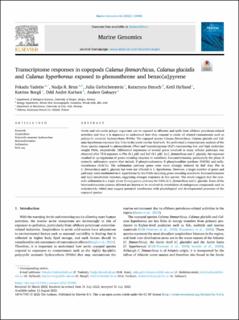| dc.contributor.author | Yadetie, Fekadu | |
| dc.contributor.author | Brun, Nadja Rebecca | |
| dc.contributor.author | Giebichenstein, Julia | |
| dc.contributor.author | Dmoch, Katarzyna | |
| dc.contributor.author | Hylland, Ketil | |
| dc.contributor.author | Borgå, Katrine | |
| dc.contributor.author | Karlsen, Odd André | |
| dc.contributor.author | Goksøyr, Anders | |
| dc.date.accessioned | 2022-09-07T09:28:52Z | |
| dc.date.available | 2022-09-07T09:28:52Z | |
| dc.date.created | 2022-08-24T08:45:19Z | |
| dc.date.issued | 2022 | |
| dc.identifier.issn | 1874-7787 | |
| dc.identifier.uri | https://hdl.handle.net/11250/3016237 | |
| dc.description.abstract | Arctic and sub-arctic pelagic organisms can be exposed to effluents and spills from offshore petroleum-related activities and thus it is important to understand how they respond to crude oil related contaminants such as polycyclic aromatic hydrocarbons (PAHs). The copepod species Calanus finmarchicus, Calanus glacialis and Calanus hyperboreus represent key links in the arctic marine food web. We performed a transcriptome analysis of the three species exposed to phenanthrene (Phe) and benzo[a]pyrene (BaP) representing low and high molecular weight PAHs, respectively. Differential expression of several genes involved in many cellular pathways was observed after 72 h exposure to Phe (0.1 μM) and BaP (0.1 μM). In C. finmarchicus and C. glacialis, the exposure resulted in up-regulation of genes encoding enzymes in xenobiotic biotransformation, particularly the phase II cytosolic sulfonation system that include 3′-phosphoadenosine 5′-phosphosulfate synthase (PAPSS) and sulfotransferases (SULTs). The sulfonation pathway genes were more strongly induced by BaP than Phe in C. finmarchicus and C. glacialis but were not affected in C. hyperboreus. However, a larger number of genes and pathways were modulated in C. hyperboreus by the PAHs including genes encoding xenobiotic biotransformation and lipid metabolism enzymes, suggesting stronger responses in this species. The results suggest that the cytosolic sulfonation is a major phase II conjugation pathway for PAHs in C. finmarchicus and C. glacialis. Some of the biotransformation systems affected are known to be involved in metabolism of endogenous compounds such as ecdysteroids, which may suggest potential interference with physiological and developmental processes of the copepod species. | en_US |
| dc.language.iso | eng | en_US |
| dc.publisher | Elsevier | en_US |
| dc.rights | Navngivelse 4.0 Internasjonal | * |
| dc.rights.uri | http://creativecommons.org/licenses/by/4.0/deed.no | * |
| dc.title | Transcriptome responses in copepods Calanus finmarchicus, Calanus glacialis and Calanus hyperboreus exposed to phenanthrene and benzo[a]pyrene | en_US |
| dc.type | Journal article | en_US |
| dc.type | Peer reviewed | en_US |
| dc.description.version | publishedVersion | en_US |
| dc.rights.holder | Copyright 2022 the authors | en_US |
| dc.source.articlenumber | 100981 | en_US |
| cristin.ispublished | true | |
| cristin.fulltext | original | |
| cristin.qualitycode | 1 | |
| dc.identifier.doi | https://doi.org/10.1016/j.margen.2022.100981 | |
| dc.identifier.cristin | 2045518 | |
| dc.source.journal | Marine Genomics | en_US |
| dc.identifier.citation | Marine Genomics. 2022, 65, 100981. | en_US |
| dc.source.volume | 65 | en_US |

